Summary of climate disasters on the planet: May 7–13, 2025
A troubling trend has likely not escaped the attention of our regular viewers: almost every weekly report now features stories of extreme weather events occurring in Russia. This isn’t because we previously overlooked the country — it’s simply that severe weather was far less common there. But something has changed. For reasons unknown to most, Russia is rapidly catching up with the rest of the world in both the frequency and intensity of climate-related disasters. So what is happening in this country?
Read on to receive the answer to this question.
Here’s the detailed overview of the past week’s events, from May 7 to 13, 2025.
Russia
On May 8, a rare phenomenon struck the Tobolsky state farm area in the Svetlinsky District of Orenburg Region. A powerful tornado swept through the settlement, throwing locals into a panic.
The storm was accompanied by egg-sized hail that caused major damage to cattle barns, resulting in injuries and fatalities among the livestock.
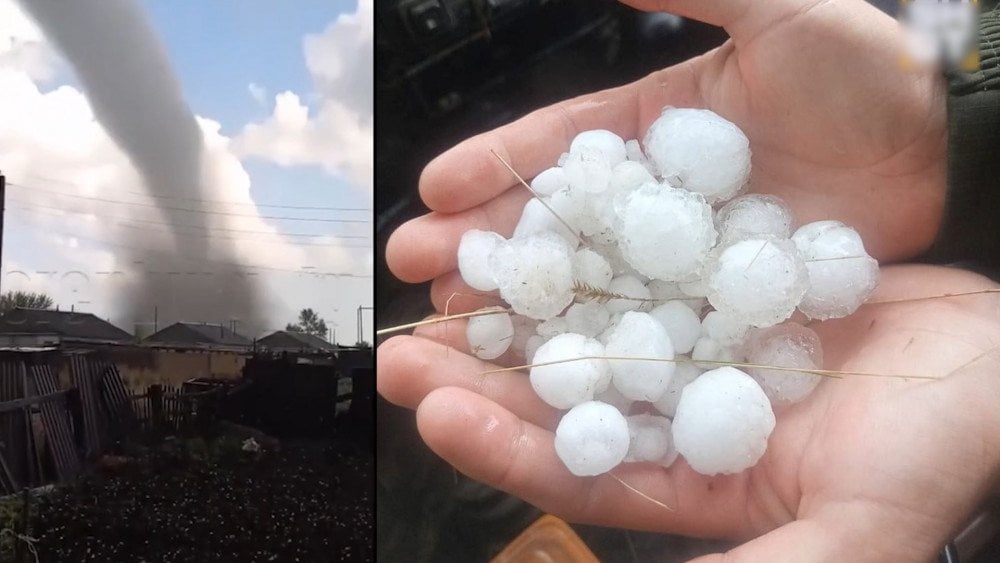
Violent weather struck southern Russia: a tornado with hail passed through Svetlinsky District in Orenburg Region
Eyewitnesses reported that there were actually two tornadoes. The second one crossed a field and quickly dissipated without causing damage.
On May 8, severe thunderstorms with hail and hurricane-force winds struck regions of the North Caucasus. The storms affected the republics of Kabardino-Balkaria, Karachay-Cherkessia, Ingushetia, North Ossetia, and the Stavropol Krai.
The storm toppled trees and power poles, tearing down power lines. Hail severely damaged orchards and crops, threatening the harvest.
In North Ossetia, multiple districts — including Beslan, Vladikavkaz, Mozdok, and the villages of Olginskoye, Kosta, and Kartsa — were left without electricity.
Walnut-sized hail severely damaged fruit trees.
In the village of Kosta, winds were so strong they knocked over a monument.
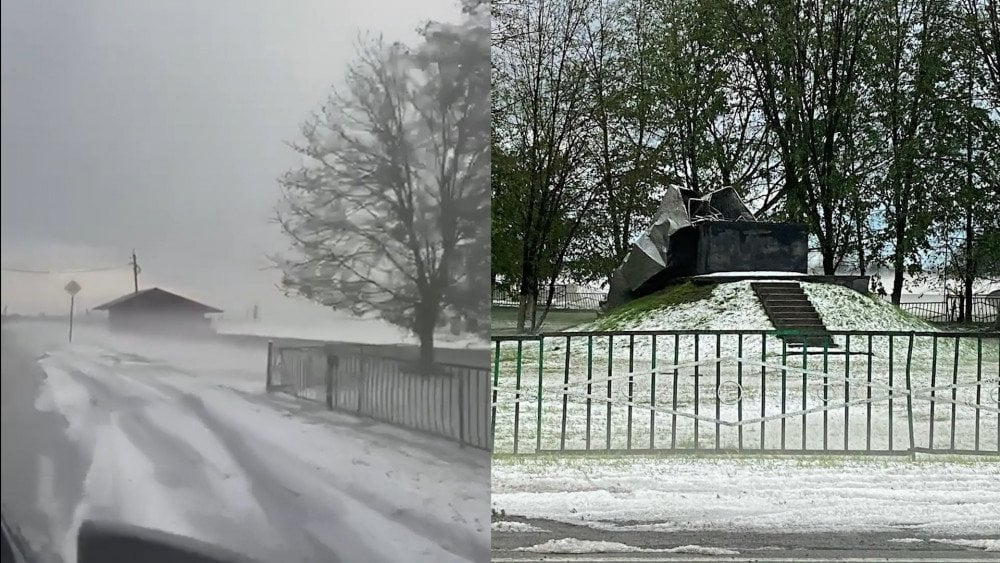
Roads after the hailstorm (left), monument toppled by powerful wind (right) in Kosta village, North Ossetia, Russia
In Vladikavkaz, a tree crashed onto a car, injuring two people. One person was taken to the hospital in serious condition.
On May 12, a hailstorm in the village of Storozhevaya, Karachay-Cherkessia, wiped out crops that residents had invested their hopes and savings in — food they were counting on to feed their families and earn a living.
In the Stavropol Krai on May 9, after prolonged rains, water rushed in from the fields and flooded the village of Ovoschi in the Turkmen District. The water level in some homes reached 1.5 meters (4.9 ft). Floors were damaged, and furniture and household appliances were ruined. A section of the regional road—from the village of Poperechny to Ovoschi—was also flooded.
In the Georgievsky District, a state of emergency was declared. Here, hail the size of a walnut damaged more than 10,000 hectares (24,700 acres) of wheat, barley, corn, sunflower, pea, and flax crops. Losses ranged from 20% to 100%.

Minibus crossing a flooded street after a powerful hailstorm, Georgievsky District, Stavropol Territory, Russia
On May 12, the town of Solnechnodolsk was hit by a rare and hard-to-predict weather event known as a “rain bomb” or “wet microburst”—a powerful downdraft of air accompanied by intense rain and damaging winds.
The storm damaged water infrastructure, cutting off water supplies to several neighborhoods.
Democratic Republic of the Congo
From May 8 to 9, torrential rains hit the eastern part of the Democratic Republic of the Congo, with South Kivu Province especially hard-hit. A small river near the town of Fizi overflowed its banks, sending a raging torrent of water, mud, trees, and rocks through the area.

Aftermath of the sudden flood in South Kivu province, DR Congo
On the night of May 9, disaster struck the village of Kasaba. Most residents were asleep when torrents of water and mud flattened their homes. About 150 buildings were destroyed. As of May 12, at least 110 people were confirmed dead — many of them children and elderly. Another 28 were injured.
Rescue efforts were hampered by washed-out roads and lack of communications. The only access to Kasaba was by boat across Lake Tanganyika.
Colombia
The country is experiencing a continued and destructive rainy season. The situation is especially severe in the department of Antioquia in northwestern Colombia.
On May 8, heavy downpours triggered a powerful landslide in the municipality of Sabaneta, a suburb of Medellín — Colombia’s second-largest city. A flow of mud and debris buried several houses, destroying part of a residential neighborhood.
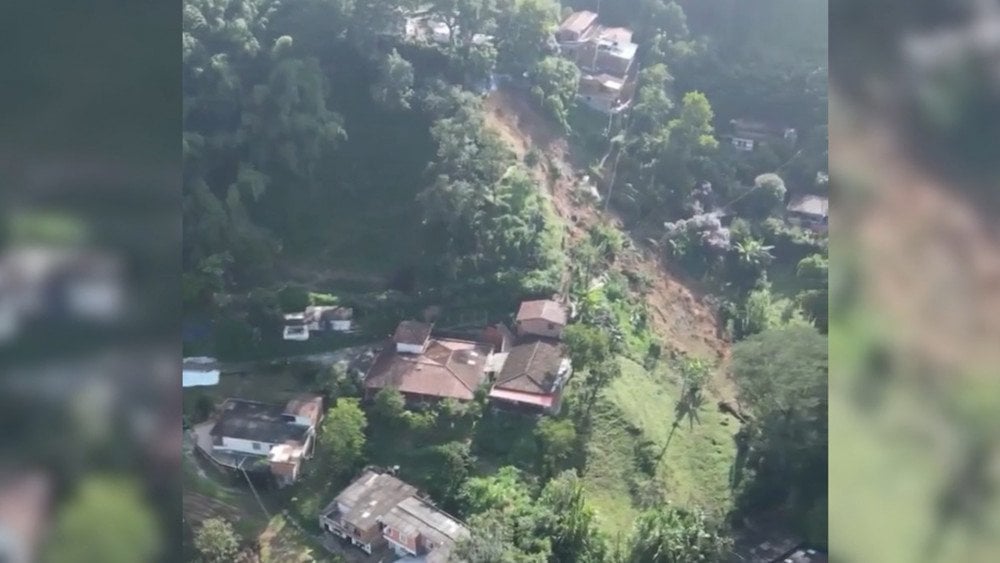
Deadly landslide triggered by torrential rains in the municipality of Sabaneta, Antioquia Department, Colombia
Seven people lost their lives. According to eyewitnesses, the ground began to move suddenly—people had almost no time to escape. Twenty-three families were evacuated and relocated to temporary shelters.
This deadly landslide is just one of hundreds of incidents caused by extreme weather in Antioquia. A red alert level has been declared in 72 of the department’s 125 municipalities.
And in Medellín, more than 1,000 emergencies have been recorded since the beginning of May.
Due to heavy rainfall, one of the country's largest rivers—the Cauca—overflowed its banks, flooding dozens of neighborhoods.
Brazil
On May 9, a wave of storms swept across southern Brazil, impacting the northern part of Rio Grande do Sul state and the western part of Santa Catarina state. In Rio Grande do Sul, torrential rain, strong winds, and tornadoes caused damage in nearly 40 cities. Reports of roofs torn off, collapsed utility poles, and fallen trees came in continuously.
In the city of Cachoeira do Sul, 188.2 mm (7.41 in) of rain fell in a single day—one and a half times the average rainfall for May (monthly average is 120 mm / 4.72 in).
The most severe event occurred in the municipality of Erval Grande, where a tornado destroyed or damaged 285 homes and 23 industrial buildings, and completely wiped out about 30 hectares (74 acres) of eucalyptus plantations.
As the whirlwind passed through the forest, it left a trail of hundreds of broken trees.
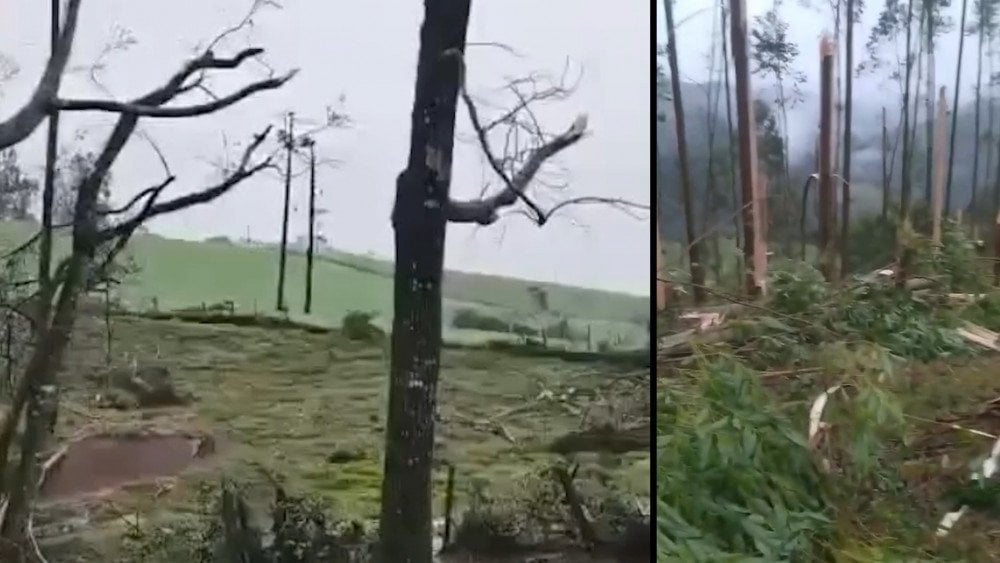
Eucalyptus plantations damaged by tornado—hundreds of trees broken and destroyed, municipality of Erval Grande, Rio Grande do Sul state, Brazil
In the city of Triunfo, a nursing home was damaged. Firefighters evacuated the elderly residents and placed them in a temporary shelter.
In Santa Catarina state, the storm caused destruction and claimed the lives of two people who were struck by falling trees. Wind gusts in some regions exceeded 100 km/h (62 mph). In the municipality of Itapiranga, atmospheric microbursts were recorded—sudden, powerful, and destructive downward air currents. In the city of Palmitos, the area hardest hit by the storm, houses were destroyed, pipelines and roads were damaged, and trees and utility poles were knocked down. A section of one of the country’s longest federal highways—BR-158—was also blocked.
Agricultural land suffered damage.
In the municipality of Mondai, strong winds caused the collapse of a school gymnasium wall. Six children who were inside sustained injuries. The Greater Florianópolis metropolitan area was also impacted by the storm: in the municipality of Palhoça, unusually large hail was reported.
Ukraine
Starting May 8, Ukraine was gripped by abnormally cold weather. The average daily air temperature was 5–9 °C (9–16 °F) below normal. Frosts were recorded across nearly the entire country. People tried to save their future harvests by covering crops with agrofabric and lighting fires. But not everything could be saved. In many areas, fruit, nut, and melon crops were lost. Vineyards and strawberries froze.

Frozen strawberry bushes—aftermath of abnormal May frosts in Ukraine
In Lviv, daily minimum temperature records were broken two days in a row: on May 11, the temperature dropped to −0.2 °C (31.6 °F), and on May 12—to 0 °C (32 °F).
It hasn’t been this cold here in the last 47 years (the previous cold records were broken in 1978).
In the city of Rivne, on May 9, the temperature fell to −2.5 °C (27.5 °F). This is the lowest temperature ever recorded there after May 4th. Minimum temperatures on May 11 and 12 were also low: −0.8 °C (30.6 °F) and −0.5 °C (31.1 °F), respectively.
Ground-level frosts were even more severe. In Rivne Region, plants died even inside greenhouses. Since May 8, snow fell for several consecutive days in the Carpathians—a surprise for both tourists and local residents.
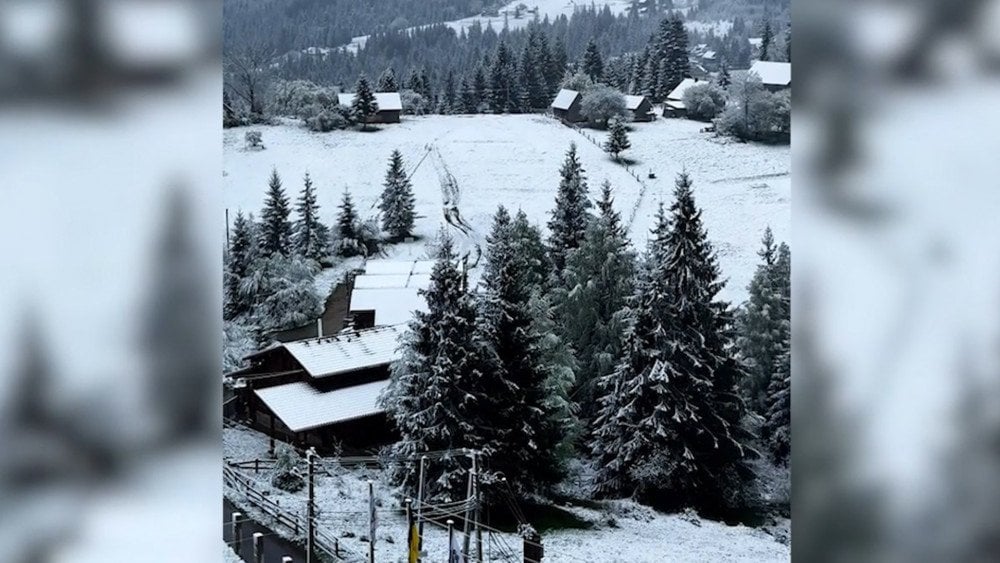
May snowfall in the Carpathians—the unexpected return of winter amazed tourists and locals
Snow cover was recorded in Chernivtsi and Ivano-Frankivsk Regions. On Mount Pip Ivan, a true winter storm raged, and the temperature dropped to −7 °C (19.4 °F).
On May 9, a series of storms with heavy precipitation, hail, and strong winds swept across several regions. Pavlohrad in Dnipropetrovsk Region was struck by a tornado, damaging homes, cars, and power lines. In the city of Zaporizhzhya, heavy downpours were accompanied by abnormally large hailstones up to 5 cm (2 in) in diameter.

Large hail fell in Zaporizhzhya, Ukraine
In Odesa Region, strong wind gusts left 55 settlements without electricity—18,000 families were affected.
On May 12, hailstorms passed through Cherkasy Region. In the city of Zolotonosha, eyewitnesses filmed a large tornado. Fortunately, no destruction was reported.
Romania
Since May 6, extreme weather conditions have continued to wreak havoc across Romania. Severe storms brought a true disaster to Dolj County, flooding more than 100 homes in the village of Carăuľa and damaging around 3,500 hectares (8,650 acres) of farmland.

Flooded fields in Dolj County, Romania—the disaster dealt a serious blow to agriculture
In Mehedinți County, large hail destroyed vineyards, along with onion, garlic, and other crop fields. An 82-year-old local resident said that he had never seen anything like it in his entire life.
Several county roads were completely blocked by floodwaters, severely disrupting transportation.
On May 11, a wave of Arctic air swept over the country, causing unseasonably cold temperatures for mid-May.
Snowfall hit the northern part of the country. The hardest-hit regions were Maramureș, eastern and southeastern Transylvania, northern Moldova, and the Western Hills. Blizzards raged in the Rodna Mountains, with snow cover reaching 10 cm (3.9 in).

May snowfall in the Rodna Mountains, northern Romania
May 12 became the coldest day in the past 50 years, breaking the historical daily temperature record. In the city of Miercurea Ciuc, temperatures fell to −3.6 °C (25.5 °F). The previous record low of −1.5 °C (29.3 °F) was set in 1974.
On Omu Peak, a temperature of −7 °C (19.4 °F) was recorded. The cold set in so suddenly that many people had to urgently buy extra firewood to stay warm. Due to the heavy snowfall, the opening of the Transfăgărășan Highway—Romania’s second-highest alpine road—was postponed until the end of the month.
Seismic Activity
On May 13, a series of 49 earthquakes struck the Campi Flegrei area, Europe’s most dangerous supervolcano, including tremors of magnitude 4.4 and 3.5. The epicenter was located near the city of Pozzuoli.
The Campi Flegrei caldera is one of the most hazardous volcanic systems in Europe, located in a densely populated area that includes the cities of Naples and Pozzuoli.
The seismic swarm led to the evacuation of schools and public buildings, the suspension of regional rail service, and the activation of emergency coordination centers.
It is important to note that more than 500,000 people live in the red zone—the area in immediate proximity to the caldera.
The Ministry of Civil Protection declared a state of emergency, as the region has been experiencing a prolonged seismic swarm for several months. Some of the tremors have been clearly felt by local residents, causing damage and injuries.

Aftermath of a series of tremors in the Campi Flegrei caldera area, Italy
In the past, earthquakes of magnitude greater than 4 occurred here only once every few decades—but in just the past two months, two such events have already been recorded: on March 13, 2025—a magnitude 4.6 earthquake; on May 13, 2025—a magnitude 4.4 earthquake.
On the same day, May 13 at 22:51 UTC (May 14 at 00:51 local time), a powerful M6.1 earthquake was recorded in Greece, near the island of Crete. The hypocenter was located at a depth of 71 km (44 mi). The quake was felt across the eastern Mediterranean, including in Israel, Egypt, Turkey, Jordan, and Lebanon.
China
This spring, China is experiencing an extraordinary wave of extreme weather events, many of which are being described as “the rarest in a century.”
An unusual combination of atmospheric phenomena led to the formation of a storm line delivering torrential rains, thunderstorms, squalls, and tornadoes across vast regions in both the north and south of the country.
On May 8, a tornado struck Hunan Province. In Yueyang County, 6 houses were destroyed, over 100 others were damaged, cars were shattered by hail, and fruit trees were broken.

Strong storm damaged the roof of a building, China
In Hengyang County, in the village of Pingtan, Buyunqiao Township, a tornado destroyed a residential house, trapping two elderly people under the rubble. Unfortunately, both died.
Most weather stations across the provinces of Hunan, Hubei, and Jiangxi recorded hurricane-force wind gusts ranging from 9 to 14 on the extended Beaufort scale 20.8 to 46.1 m/s (roughly 47 to 103 mph).
Rainfall totals were also anomalously high. In Qimen County, Anhui Province, 87 mm (3.43 in) of rain fell in just one hour. Twenty-four meteorological stations in Beijing and Hebei Province broke previous May precipitation records. Even in Shanghai, which had been suffering from drought, there were downpours as intense as those typically seen during a typhoon.
That same day, the city of Xi’an in Shaanxi Province was suddenly hit by hailstones the size of chicken eggs. A car dealership owner shared in despair that out of more than 300 vehicles on display, not a single one was spared—bodies were dented and all windows shattered.

China hit by powerful hailstorm
As the convective storms moved south, they became increasingly dangerous. The proximity to the South China Sea increases humidity levels, providing additional fuel for the storms and making them comparable in strength to typhoons.
It's now clear that residents of the southern provinces can be hit by such powerful events at any time of year—not just during typhoon season.
In just 24 hours, the city of Yangjiang in Guangdong Province saw over 250 mm (about 10 inches) of rainfall. There was so much rain that people were wading waist-deep through the water.
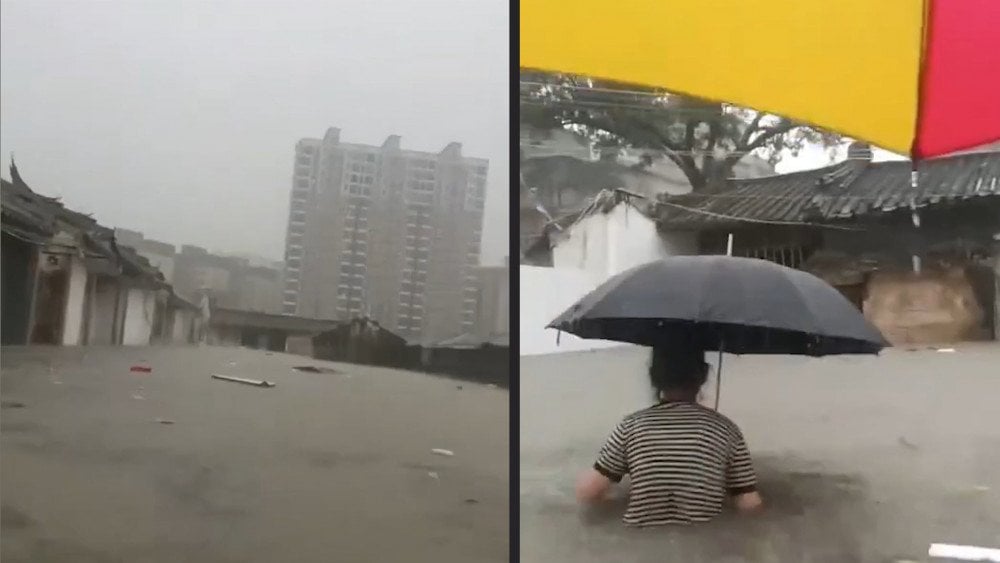
Severe flooding in China after record rainfall
On May 10, a tornado hit the Longfeng company’s logistics park in Hainan Province. In just seconds, the storm destroyed half of the factory buildings.
The destruction covered an area of about 2,700 m² (29,000 ft²). Fortunately, no employees on site were injured.
So why has Russia only recently begun to experience a clear surge in climate-related disasters, while the rest of the world has been dealing with escalating extreme weather for over a decade? While some mystical theories have circulated online, the explanation lies in a purely technical domain.
The mitigation of climate disasters had been supported by experimental equipment developed by the interdisciplinary scientific group ALLATRA. From 2013 to 2023, the operation of this equipment had a stabilizing effect—primarily over Russia and Eastern Europe. By influencing atmospheric and hydrospheric processes, it helped suppress high winds, storms, and abnormal precipitation.
As a result, the number of extreme weather events in Russia grew much more slowly, even though temperatures in Siberia were rising 2.5 to 3 times faster than the global average due to the activity of the Siberian magmatic plume.
The equipment was placed in Russia not for political reasons or personal preferences, but because of the significant geodynamic threat posed by the plume—an eruption of which could potentially wipe out all life on the planet.
However, in August 2023, the operation of the installation was forced to stop. Almost immediately afterward, a sharp increase in the frequency and intensity of extreme weather was recorded in Russia and parts of Eastern Europe—a trend that continues to accelerate.
Dr. Egon Cholakian, a member of the ALLATRA research team, has publicly addressed key questions: Why was the equipment shut down? What physical principles was it based on? Who made its development possible? He also explained what is happening to Earth’s climate more broadly and what solutions already exist today that could slow the escalation of natural disasters.
We strongly encourage you to watch Dr. Cholakian’s address carefully and consider the information presented. Our collective future, quite literally, depends on it.
You can watch the video version of this article here:
Leave a comment